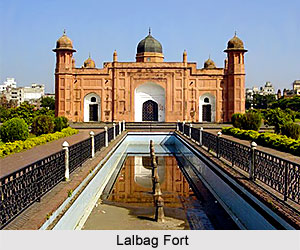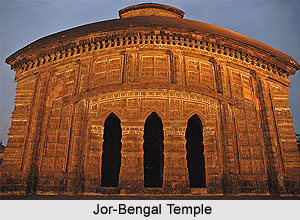 Mughal architecture in Bengal was a domain, which had entirely rested in the primary necessity to consolidate this eastern Indian region, considered to hold huge significance since the times of Akbar. Emperor Akbar is legendary to have served a role suitable as a Mughal with much well-judgement and righteous judicial opinion. It was precisely during his period that the special and meritorious domain of `Mughal Architecture` had begun to flourish to its fullest. Previously, during the times of Babur or Humayun, the Persian and Timurid traditions derived from the legendary and notorious Mughal forefather Timur, was very much evident in all the architectural endeavours that were finished in the Mughal capitals Delhi and Agra and its northern Indian fringes. With north India being anchored as the solid base for the spreading Mughal Empire, parts like western or eastern India were areas, which were taken into consideration in much later times. Thus, it was incumbent on a man like Emperor Akbar the Great, who would realise to extend the supremacy and hold of the Mughal Dynasty to places like Bengal, where, such basis could be established through only splendid and exquisite instances of monumental and over-the-top Mughal architecture. As such, with the intelligent assistance from ministers and nobility from the Mughal court, architecture in Bengal by the Mughals was established in a smooth and skilled manner, as was witnessed in periods of Akbar, Jahangir and Shah Jahan. Mughal architecture in Bengal, as an instance of Indo-Islamic architecture, with special stress upon the indigenous architectural pattern of Bengal, was entirely embraced by the nobles residing there and acting on behalf on the central administration in Delhi/Agra.
Mughal architecture in Bengal was a domain, which had entirely rested in the primary necessity to consolidate this eastern Indian region, considered to hold huge significance since the times of Akbar. Emperor Akbar is legendary to have served a role suitable as a Mughal with much well-judgement and righteous judicial opinion. It was precisely during his period that the special and meritorious domain of `Mughal Architecture` had begun to flourish to its fullest. Previously, during the times of Babur or Humayun, the Persian and Timurid traditions derived from the legendary and notorious Mughal forefather Timur, was very much evident in all the architectural endeavours that were finished in the Mughal capitals Delhi and Agra and its northern Indian fringes. With north India being anchored as the solid base for the spreading Mughal Empire, parts like western or eastern India were areas, which were taken into consideration in much later times. Thus, it was incumbent on a man like Emperor Akbar the Great, who would realise to extend the supremacy and hold of the Mughal Dynasty to places like Bengal, where, such basis could be established through only splendid and exquisite instances of monumental and over-the-top Mughal architecture. As such, with the intelligent assistance from ministers and nobility from the Mughal court, architecture in Bengal by the Mughals was established in a smooth and skilled manner, as was witnessed in periods of Akbar, Jahangir and Shah Jahan. Mughal architecture in Bengal, as an instance of Indo-Islamic architecture, with special stress upon the indigenous architectural pattern of Bengal, was entirely embraced by the nobles residing there and acting on behalf on the central administration in Delhi/Agra.
As a commencing factor, Mughal architecture in Bengal was primarily based in the trade cardinal centres like Burdwan, Malda or Dhaka (then coming under the purview of Bengal and its administration), with these places facilitating in all kinds of routes facilitating as business transactions. Bengal, during the times of Akbar was yet to come into an Islamic Mughal prominence, with the Hindu or indigenous other architectural kinds dominating the far eastern Indian scenario. As a consequence, it was firstly necessary for the Mughal royal household to consolidate and strengthen the regions, prior to grounding immemorial creations. Bengal`s scenario and its association with Mughal architecture during Akbar`s rule from 1556 to 1605, was primarily dominated by the Afghan rebel forces, who were primarily intimidated to rise up against the ruling clan of India, thus giving birth to a class of thoroughly new kind of architecture. Architecture in Bengal during Akbar, all throughout was thus a witnessing of a perfect amalgamation of Mughal architecture and the idiom of Afgani troops in assaying to create a masterwork in the form of tombs and mosques. However, in the form of Raja Man Singh, a wise Hindu noble from Mughal times, Hindu-Mughal architecture in Bengal was governed mostly in the arena of Rajmahal, the Bengal capital. The facia and expression of mosques and tombs in full forms of stone was one divergence which is noticed in architecture in Bengal under Akbar.
With the advent and crowning of Jahangir to the Mughal throne, Mughal architecture in Bengal was somewhat changed in the above mentioned facia and expressionistic medium. Mughal architecture in Bengal during Jahangir however also had to forcefully contend and compete with the Afghan petty rebel forces, though with a lesser intensity as compared to the times of his father, Akbar. Yet, the overriding factor in association with Bengal`s `Mughal-ish` architecture under Jahangir had not turned out to be that much fruirful under His Highness`s stellar presence. Rajmahal here too had gained prominence, however with an increased graph of patronaged works by nobility taking up the place in stead of the emperor himself. The only authenticated extant of Mughal architectural remains in Bengal under Jahangir, is the Jami mosque at Atiya in Tangail District (in present-day Bangladesh), which can somewhat speak about the emperor`s prowess in Bengal`s Mughal architectural potential and its usage of locally-available raw materials.
 It was precisely during Jahangir`s time that Shah Jahan as a prince had already begun to muster the art of Mughal excellency and brilliance in architecture, displaying signs of zealous and ardent interest to pursue as the heir apparent to the Delhi throne. However, Shah Jahan is not much of prominence and distinction in relation to Mughal architecture in Bengal, with his time mostly being centred upon the much loftier monuments in Delhi and Agra. However, under the locally hired or already-established patronised noblemen in Bengal, architecture of Bengal during Shah Jahan did become successful enough to leave a mark in areas moved away from the central business capital, Calcutta. As a result, the task of refreshing and refurbishing Bengal and its Mughal architecture was thus gladly taken up by the next heir to Mughal Empire, Emperor Aurangzeb. Architecture of Bengal during Aurangzeb had significantly moved from the erstwhile capital of Rajmahal, moving forward towards Dhaka, which once more had gained prominence in the late Mughal period. The ministers from Dhaka as a result had well ahead begun to plan for the mosques which had seized prominence, with the most striking being the Lalbagh Fort. Indeed, besides the establishments of Jami mosque - an insignia of Mughal architecture in practically every part of India that they had covered also had made its presence in Bengal.
It was precisely during Jahangir`s time that Shah Jahan as a prince had already begun to muster the art of Mughal excellency and brilliance in architecture, displaying signs of zealous and ardent interest to pursue as the heir apparent to the Delhi throne. However, Shah Jahan is not much of prominence and distinction in relation to Mughal architecture in Bengal, with his time mostly being centred upon the much loftier monuments in Delhi and Agra. However, under the locally hired or already-established patronised noblemen in Bengal, architecture of Bengal during Shah Jahan did become successful enough to leave a mark in areas moved away from the central business capital, Calcutta. As a result, the task of refreshing and refurbishing Bengal and its Mughal architecture was thus gladly taken up by the next heir to Mughal Empire, Emperor Aurangzeb. Architecture of Bengal during Aurangzeb had significantly moved from the erstwhile capital of Rajmahal, moving forward towards Dhaka, which once more had gained prominence in the late Mughal period. The ministers from Dhaka as a result had well ahead begun to plan for the mosques which had seized prominence, with the most striking being the Lalbagh Fort. Indeed, besides the establishments of Jami mosque - an insignia of Mughal architecture in practically every part of India that they had covered also had made its presence in Bengal.
Mughal architecture in Bengal during Aurangzeb however had dared to look farther from Jami mosques, standing in the unusual building structure and framework of the Lalbagh Fort and its usage of locally made raw materials.



















